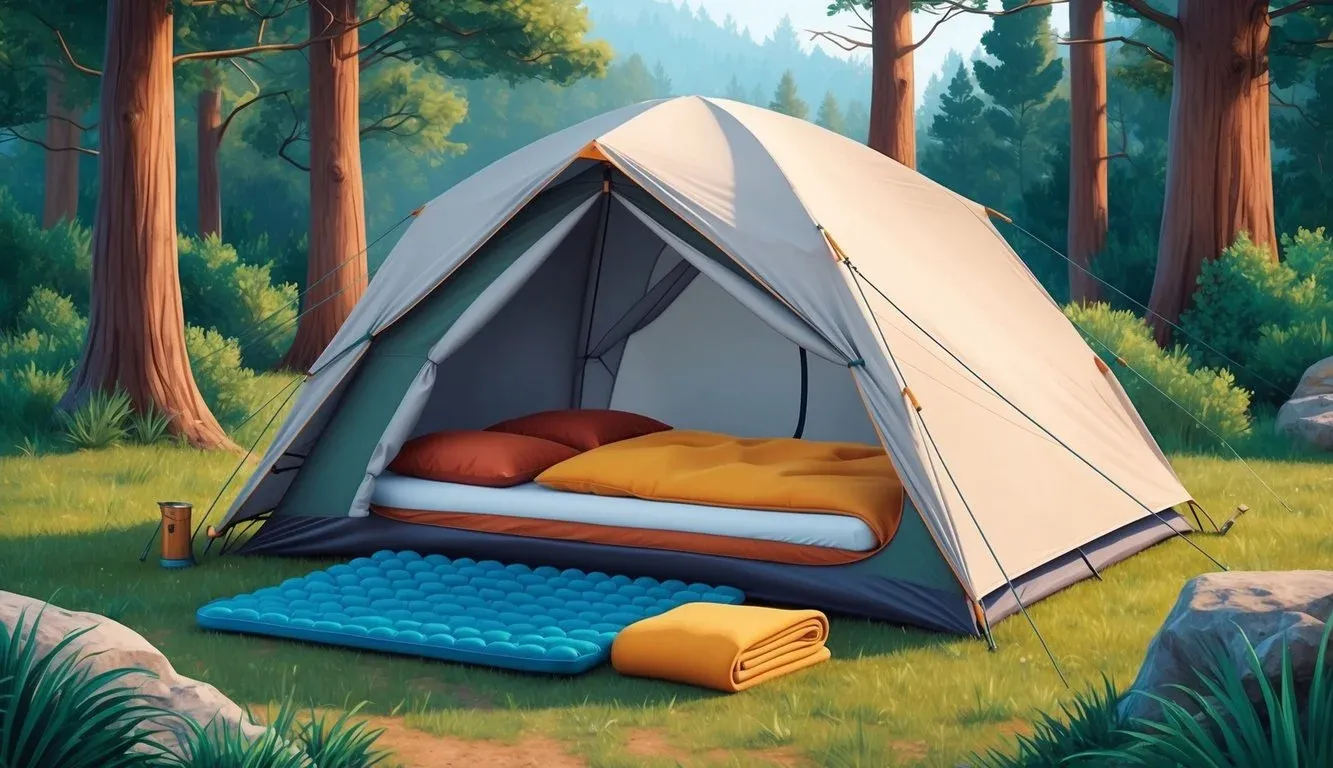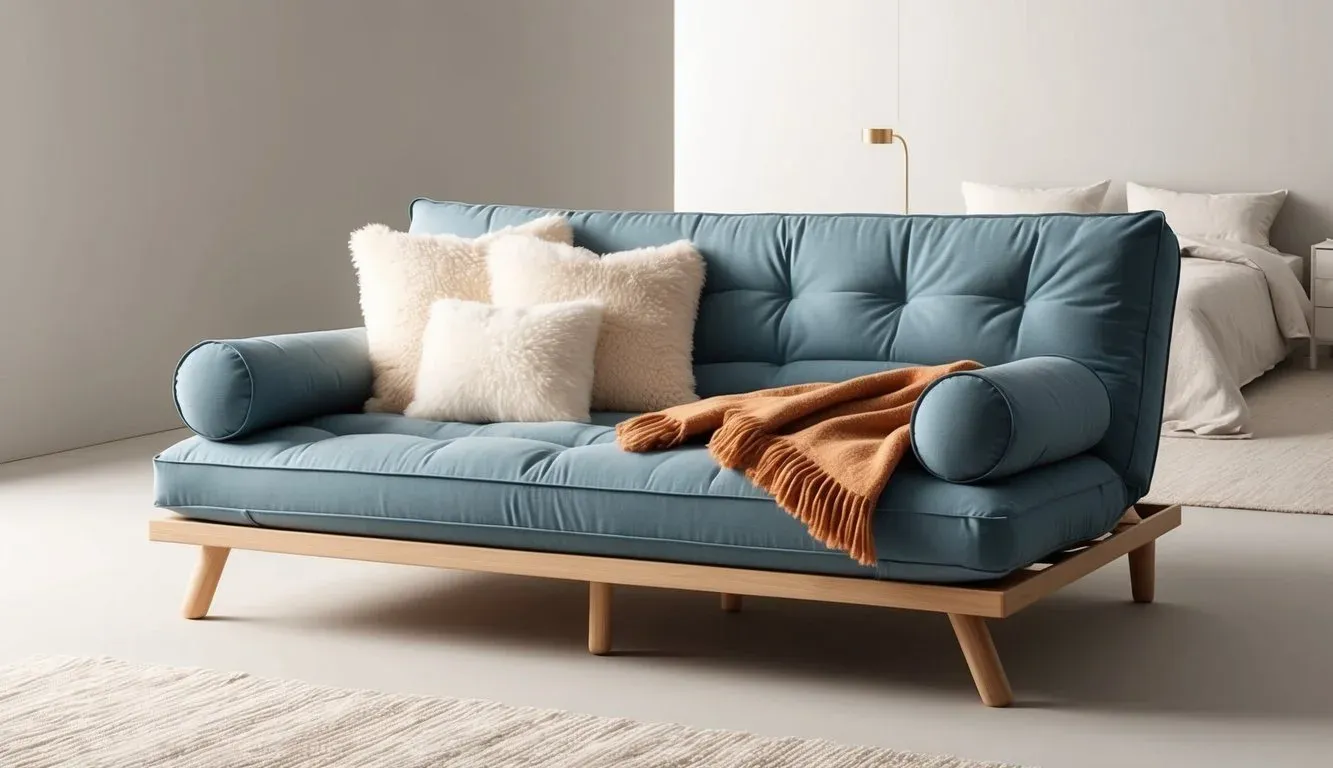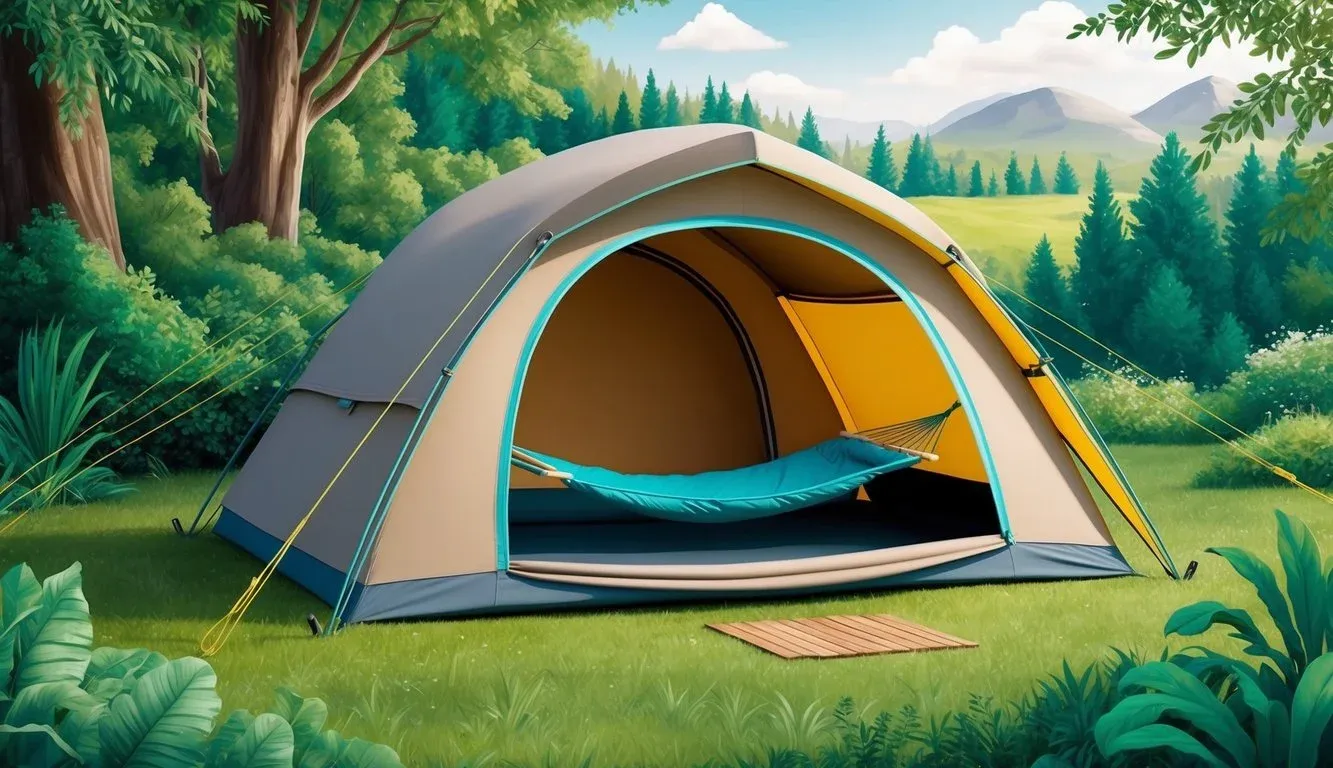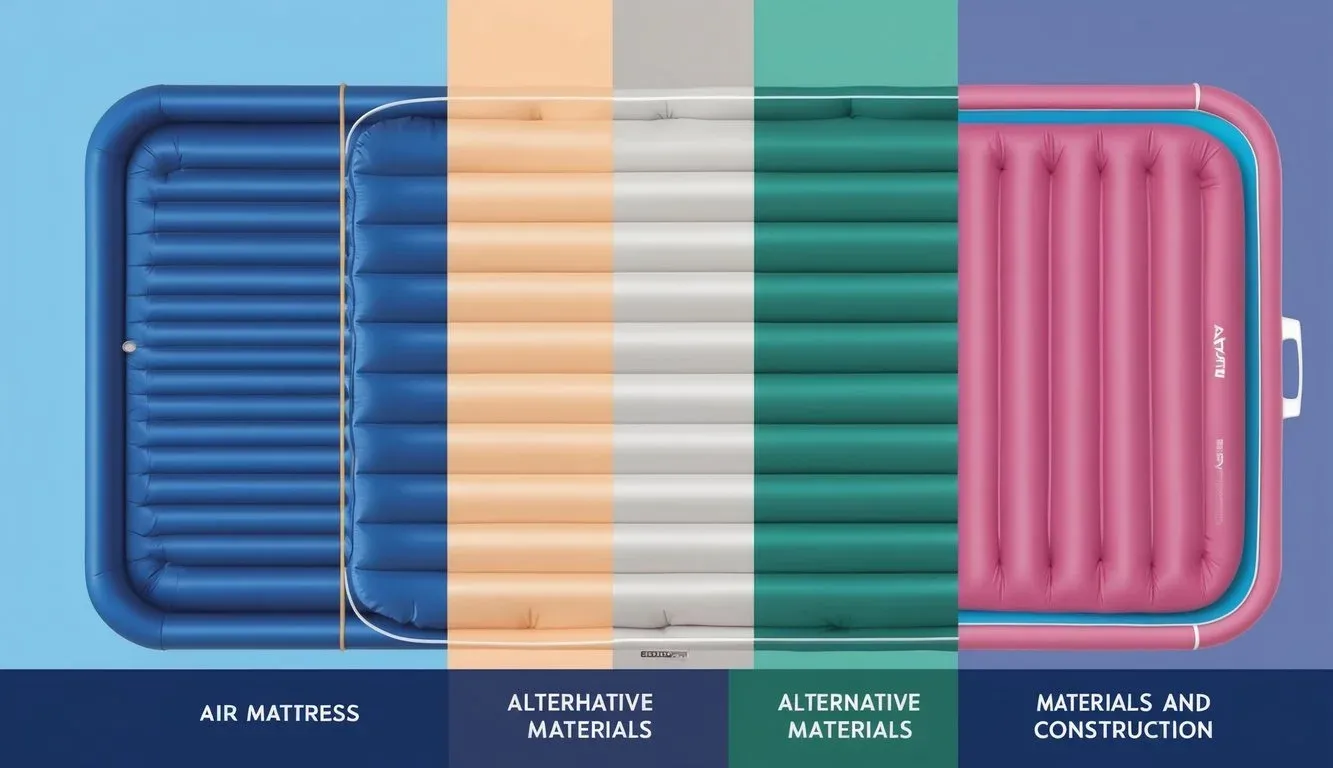Not everyone finds air mattresses comfortable or easy to use. Whether someone is looking for a better night’s sleep, a quick guest bed, or something easier to set up, there are other choices that can work just as well. Foam pads, folding cots, and futons are some of the best air mattress alternatives available today.

Each option comes with its own benefits, like better support, more durability, or easier storage. Some are lighter, while others can handle more weight for longer periods. By learning about these alternatives, anyone can find a sleeping solution that fits their needs without settling for a bulky or leaky air mattress.
Why Consider Alternatives to Air Mattresses?

Many people turn to air mattresses for quick, portable sleeping options. However, these beds can come with some issues, and different situations may be better served by other types of sleep solutions.
Common Drawbacks of Air Mattresses
Air mattresses often face problems with durability. Small punctures or leaks can quickly lead to deflation overnight, even with careful use.
Valves can sometimes fail, causing slow leaks that aren’t always easy to spot. It can be frustrating to wake up to a half-flat bed after spending time inflating it.
Noise is another concern. Some air mattresses can squeak when people move on them, which may disturb sleep. They also tend to lack support compared to traditional beds, which can be uncomfortable for people with back pain.
Inflation and deflation require extra effort. Manual pumps are tiring, while electric pumps can be noisy. Either method takes extra time.
Situations Where Alternatives Excel
Alternatives can be better in many scenarios. For camping, a foam pad or self-inflating mat is lighter, more durable, and silent. It won’t lose air or make noise, making it easier to sleep in the outdoors.
For guests at home, a folding cot or memory foam floor mattress is often sturdier and more comfortable. These options provide reliable support and do not have to be inflated or checked for leaks.
If portability is needed, roll-up sleeping pads and Japanese futons are easy to carry and store. They don’t need a pump or power source and can be set up quickly.
These alternatives are less likely to break or deflate and require less maintenance. People who move often or who have limited storage also find them handy.
Best Air Mattress Alternatives – Top Picks

People looking for another way to sleep comfortably while traveling or hosting guests have a few strong options. These alternatives focus on support, portability, and comfort using different materials and styles.
Memory Foam Mattresses
Memory foam mattresses are known for their ability to contour to the shape of the user’s body. This material offers pressure relief, which helps reduce aches and pains after sleep. Many find that memory foam gives a balanced feeling of softness and support, making it more comfortable than an air mattress, especially for side sleepers.
Unlike air mattresses, memory foam resists sagging and doesn’t lose air overnight. Most memory foam mattresses are heavier and less portable but work well for situations where the mattress can stay in one place. They come in different thicknesses and firmness levels to match personal comfort needs.
Some memory foam options are made with cooling layers to prevent overheating. Most brands offer the mattress in a bed-in-a-box style for easier transport. Common sizes range from twin to king, fitting standard bed frames.
| Pro | Con |
|---|---|
| Excellent support | Less portable |
| Pressure relief | Can retain heat |
| Long-lasting materials | Heavier to move |
Foam Camping Pads
Foam camping pads are an easy-to-carry option for sleeping outdoors or on the go. Made from dense closed-cell foam, these pads resist moisture and offer basic comfort with minimal weight.
They’re commonly rolled or folded for travel. This makes them ideal for hikers or campers who need a lightweight, simple sleep setup. A foam pad will not pop or leak like an air mattress, so it is reliable on any surface, even rough ground.
While support is limited compared to memory foam, these pads help insulate from cold floors and add a layer of cushion. Many choose foam camping pads for their durability, low cost, and resistance to damage.
| Advantages | Disadvantages |
|---|---|
| Lightweight | Thin comfort layer |
| Water-resistant | Less cushy feel |
| Very portable | Limited support |
Folding Mattresses
Folding mattresses, also called tri-fold or guest mattresses, provide foam comfort that can be easily stored. They are made from polyurethane, memory foam, or a blend of materials. These mattresses fold into two or three sections, making them compact and portable when not in use.
Folding mattresses are often about 4–6 inches thick, which is more cushion than most camping pads and sometimes rival the comfort of a standard foam mattress. Some come with removable, washable covers for easy cleaning. Because they can fold up, they fit well in closets or cars.
They are popular for use in guest rooms, sleepovers, or for travel where space is limited. While they are generally more comfortable than an air mattress, they may not last as long as a traditional bed.
| Feature | Description |
|---|---|
| Portability | Easy to store and move |
| Comfort | Soft foam, moderate support |
| Use case | Guest beds, travel, playrooms |
Innovative Sleeping Solutions

New types of sleeping gear offer more comfort and support than basic air beds. These options use advanced materials and designs, focusing on easy inflation, better insulation, and improved durability for many situations like camping or guests.
Self-Inflating Sleeping Pads
Self-inflating sleeping pads use special foam and airtight materials. When the valve is opened, the foam expands and sucks in air without a pump. Some models let users add a few breaths for a firmer feel.
These pads are valued for their easy setup and light weight. They pack smaller than most air mattresses, making them a good choice for hiking or travel. The R-value is important, showing how well the pad insulates from cold ground; higher R-values mean better warmth in chilly settings.
Self-inflating pads come in various thicknesses. Thicker pads give more comfort but may weigh a bit more. Most are made to resist leaks, though careful handling is still needed. Many brands include a repair kit and stuff sack.
A quick comparison table:
| Feature | Self-Inflating Pad | Standard Air Mattress |
|---|---|---|
| Inflation | Built-in foam | Manual or pump |
| R-value | Usually higher | Usually lower |
| Pack Size | Smaller | Larger |
| Comfort | Good | Varies |
Hybrid Sleeping Systems
Hybrid sleeping systems mix features from different sleep setups. They often combine an inflatable air chamber with layers of foam or fiberfill. This gives both support and cushioning, aiming for a balance missing in many regular air beds.
Most hybrids use a built-in pump for quick inflation and deflation. Others mix self-inflating and manual methods. The system’s top layers may add insulation and a soft feel, which helps with temperature control and comfort.
These mattresses can be used for both home and travel. Some models fold into compact bags for camping, while others have designs for guest rooms or RVs. The strong materials reduce the risk of leaks or stretching.
A quick list of hybrid system features:
- Multiple layers for support and softness
- Built-in or external pump solutions
- Choices of R-value for different climates
- More durability than standard air beds
Materials and Construction Comparison

The type of material and how it is built strongly affects comfort, durability, and how well the mattress stays warm. Certain features, like insulation, play a big role in how well someone sleeps in different temperatures.
PVC, Rubber, and Plastic Variables
Air mattress alternatives are made from several materials, mostly PVC, rubber, and other plastics. PVC (polyvinyl chloride) is strong and water-resistant but can be stiff and heavy. Some people avoid PVC due to concerns about chemicals.
Rubber is flexible and tough, often found in self-inflating mats and sleeping pads. It resists punctures better than thin plastics. However, rubber can be heavier and sometimes has a smell. Various plastics are used in lightweight pads and are easier to fold and carry.
Below is a comparison table:
| Material | Durability | Weight | Flexibility | Water Resistance |
|---|---|---|---|---|
| PVC | High | Medium | Medium | Excellent |
| Rubber | Very High | Heavy | High | Good |
| Plastic | Medium | Light | Very High | Varies |
Insulation and Warmth Factors
Insulation is key for maintaining warmth on cool nights. Some alternatives—like foam pads—trap air and body heat, keeping sleepers warmer on cold surfaces. Inflatable pads may have added insulation, such as synthetic fibers or reflective layers, to help reflect heat back to the body.
Many air mattresses without extra insulation let cold air seep through, making them less suitable for cold weather. Rubber and insulated plastic pads often list an R-value, which measures thermal resistance. Higher R-value = better warmth retention.
Those sleeping in chilly environments should look for products with extra insulation or high R-values to avoid losing warmth to the ground. This helps make the sleep experience more comfortable when temperatures drop.
Comfort and Support Considerations

Comfort and support differ across various air mattress alternatives. Key factors include pressure relief for different sleep positions and the stability of air pressure, which can also impact sleep quality.
Pressure Relief for Side Sleepers
Side sleepers need extra support to keep their spine aligned. Too much pressure on the hips and shoulders can cause pain. Memory foam and latex mattresses offer better pressure relief by molding to the body’s shape. This helps prevent uncomfortable spots from forming.
Some sleeping pads and folding beds have added cushioning. Look for options that use high-density foam or extra layers for support. Hybrid mattresses combine springs and foam. These can offer both support and softness for people who sleep on their sides.
When possible, check if the mattress or pad is labeled as side sleeper friendly. This ensures it has zones or layers made for pressure relief where it matters most. Avoid thin or low-quality inflatables, as they usually lack enough support in key areas.
Noise and Air Pressure Stability
Noise from a mattress can disturb light sleepers. Some alternatives, like memory foam or sleeping cots with fabric surfaces, are nearly silent when moving. Low-quality air beds may squeak or rustle, which can wake people easily.
Air pressure stability is also important. Traditional air mattresses can slowly lose air overnight, making them sag. Alternatives such as folding foam mattresses or hybrid cots keep their shape better, so they do not need refilling.
If choosing an alternative with air chambers, look for built-in pumps or double-sealed valves. These features help keep air pressure steady through the night. Quiet materials and sturdy constructions make sleeping more comfortable and less disruptive.
Best Alternatives for Car Camping and Travel

Different situations call for different types of sleeping solutions when on the road. Compact, durable, and easy-to-use products are most useful for both car camping and frequent travel.
Choose the Right Mattress for Car Camping
Car camping often means limited space and uneven surfaces. The best choice is often a self-inflating foam sleeping pad or a memory foam roll-up mattress.
Self-inflating pads provide a balance between comfort and convenience. They pack down small and can be set up in just a few minutes.
Memory foam mats are thicker and give more cushioning. However, they take up more storage space and are heavier. Some car campers use a folding camp cot to keep themselves off the ground.
Here is a quick comparison:
| Type | Comfort | Weight | Storage Size | Price |
|---|---|---|---|---|
| Self-inflating Pad | Medium | Light | Small | $$ |
| Memory Foam Pad | High | Heavy | Medium | $$$ |
| Folding Camp Cot | Medium | Medium | Large | $$ |
Portable Options for Frequent Travelers
People who travel often need lightweight, easy-to-carry products. The ultralight air pad and packable sleeping bag are two of the best options on the market.
Ultralight air pads are made for backpacking, so they are very compact and weigh less than two pounds. They can be inflated by mouth or with a small pump.
Some travelers use a packable sleeping bag with built-in padding. These bags save space and remove the need for a separate mattress. Others prefer inflatable travel mats, which fold down to the size of a water bottle.
Key features to look for in portable options:
- Weight under 3 lbs
- Easy inflation/deflation
- Durable fabric (nylon or polyester)
- Water-resistant or waterproof
Evaluating Pricing and Market Options

Shoppers have several choices when searching for an air mattress alternative. It is important to compare features, brands, and prices to find the best fit for both comfort and budget.
Market-Leading Brands and Models
Some of the most recognized brands for air mattress alternatives include Enerplex, Coleman, and SoundAsleep. Each brand offers different models, often with unique features such as built-in pumps, reinforced coils, or extra-thick material.
Enerplex is popular for its sturdy and quick-inflate portable beds. Coleman is often chosen for its camping-friendly designs and affordable pricing. SoundAsleep offers models with ComfortCoil Technology, focusing on stability.
Below is a table comparing a few common options:
| Brand | Key Feature | Price Range |
|---|---|---|
| Enerplex | Quick setup, portable | $75–$130 |
| Coleman | Camping design | $55–$110 |
| SoundAsleep | Comfort coils | $95–$150 |
When choosing, it helps to read reviews, check return policies, and consider where the product will be used.
Affordability and Value for Money
The price of air mattress alternatives can range from around $50 for basic models to $150 or more for premium versions. Budget-friendly options generally use less durable materials and have fewer features.
Many people consider value for money by comparing what is included in the purchase. Some options come with a pump, a carrying bag, or warranty support. Enerplex, for example, often includes a warranty and free returns for 30 days.
A simple checklist can help:
- Check included accessories
- Compare warranties
- Look for seasonal sales or bundles
Paying attention to return policies can make it easier if the mattress is not a good fit. This is especially helpful when shopping online where you can’t test the product in person.
Frequently Asked Questions

People often want to know which alternative mattresses offer comfort, support, and easy setup. Concerns like back pain, space-saving, and health risks are common when choosing the best air mattress alternative.
What are the top-rated foldable mattresses for guest use?
Popular foldable mattresses include the Milliard Tri-Fold Mattress, Lucid Foldable Mattress, and Olee Sleep Tri-Folding Memory Foam. These options store easily and expand quickly for unexpected guests. Many reviews mention that memory foam styles provide good support without being too heavy.
How can back pain sufferers find suitable alternatives to air mattresses?
Those with back pain should look for mattresses with firm support. Foam roll-up or tri-fold mattresses with high-density foam can help. Some people also use thin Japanese futons (shikibuton) placed on a firm surface.
What are the most comfortable sleeping options for outdoor camping?
Self-inflating pads, foam camping mats, and cots are often seen as the most comfortable choices for camping. Backpackers often prefer Therm-a-Rest pads or Klymit mats because they combine comfort, durability, and packability. Some choose folding camping cots for extra support off the ground.
Can folding mattresses be a good permanent substitute for traditional beds?
Folding mattresses can be used every night, but they may not last as long as standard beds. High-density memory foam models hold up better with regular use. Some people pair them with a mattress topper for added comfort.
What are the best strategies for sleeping on the floor in the absence of an air mattress?
Laying down thick blankets, comforters, or a yoga mat can help make the floor more comfortable. Japanese futons also provide more support and padding. It’s important to keep the sleeping area clean and put a sheet or cover over the padding.
Is it healthy to use an air mattress as a regular sleeping solution?
Most air mattresses are not designed for ongoing use. Long-term sleeping on an air mattress can lead to body aches or poor posture because support may weaken over time. Some people with back problems might find their pain increases if they use an air mattress daily.